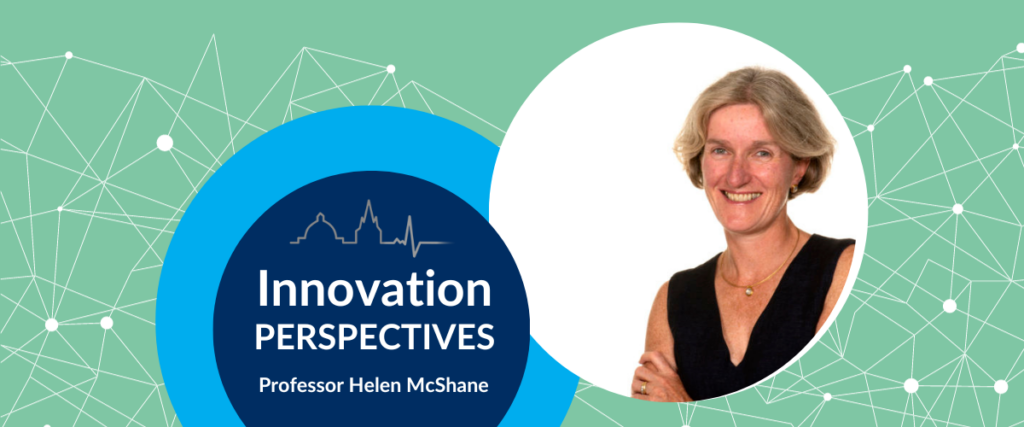Professor Helen McShane, Director of the NIHR Oxford Biomedical Research Centre, shares lessons learned from the pandemic, emphasises the importance of research infrastructure and collaboration, and outlines efforts to promote inclusive clinical research and innovation through diversity and inclusion initiatives.
“Academic career development is one of the most important things we can do to inspire, nurture and develop the next generation of clinical scientists across a whole flavour of clinical training.”
While the UK is leading the world in life sciences research, it tends to lag in adopting research and innovation into health and care systems. What do the Biomedical Research Centres (BRCs) do to help tackle this?
The BRC works at the most basic science end of the translational pipeline to fund research infrastructure which allows the whole ecosystem to flourish. This allows us to help researchers working in the fundamental basic sciences to pull their work through into the translational space, so it has a direct impact on the innovation pipeline. This means the research we support is more attractive for innovation options, whether that’s spin-out licensing or partnering with pharma, for example. The more we can establish proof of concept and develop new treatments or healthcare technologies, the more we can develop more attractive and successful things in an innovation pipeline. Since so many innovations fail on their development journey, we need a really vibrant pipeline. We can fill this pipeline from the BRC.
The BRC’s collaborative approach to research was demonstrated by Oxford’s response to COVID-19. What have you learned from this?
The biggest lesson we learned was the value of research infrastructure. During the pandemic, Oxford was largely able to deliver impactful research because of 15 years of BRC-funded infrastructure. This was most obviously demonstrated in the Vaccines Theme, where we had groups of researchers already working on a related coronavirus who were able to immediately pivot and use their existing research infrastructure to develop the SARS CoV2 vaccine.
In a global emergency like a pandemic, this infrastructure – which ordinarily takes time to be built – really allows us to move very quickly and deliver what’s needed. So, I feel very strongly about the importance of maintaining that infrastructure.
The second lesson was that we can indeed do things differently. While we can’t all work at the pace we did during the pandemic, we can work together to streamline how we work so clinical research is more efficient. The RECOVERY trial, for example, was a very simply designed trial platform that used already licensed medicines. This meant they could be rolled out and tested across the country in partnership with many clinical sites, allowing the trial to recruit patients very quickly. We are now seeing colleagues in respiratory medicine looking at the RECOVERY model to roll out other treatments for respiratory diseases.
The BRC has an extensive training offering to support the development of clinical academic careers. What more do you think can be done to embed a culture of collaboration in clinical research?
Academic career development is one of the most important things we can do to inspire, nurture and develop the next generation of clinical scientists across a whole flavour of clinical training. One of the ways we do this is through a partnership with Dr Helen Walthall, Head of Nursing Research for the OUH NHS Foundation Trust, where we are developing academic career pathways for nurses, midwives and allied health professionals by offering pre- and post-doctoral support for internships and other research support opportunities.
We also have a variety of mechanisms to expose healthcare professionals to research so they can see how valuable it can be. There is a very strong and effective model in Oxford’s medical space of researchers having joint appointments with parallel clinical and academic tracks. I think we now need to use this as a model for developing nurses, midwives and allied health professionals as researchers. It’s important that we do this in Oxford, and I would like to see us leading this across the country, because it will support us with recruitment and retention and will help to make our colleagues roles more interesting and engaging.
How can clinical research be more inclusive so the health and care needs of all members of the community are identified and catered for?
We are doing a lot of work to embed equality, diversity and inclusion (EDI) across our BRC, working with our partners, the University and the NHS. This work cuts across both patient participation in research and EDI in our staff groups and researchers, each of which has a different approach.
We have recently established a Diversity in Research Group across both BRCs in Oxford, which aims to reach the areas of Oxford that our research doesn’t usually reach, including, in part, the areas of extreme poverty in our city. This group helps us to reach diverse groups of patients with opportunities to not only participate in our clinical trials, but to inform the research we do. Co-creating research in this way means we can reach communities where the diseases that we work on are most prevalent, with research projects that address the questions that patients have, so our research is as relevant and applicable as it can be.
In terms of diversity in our staff group, we’re keen to make sure that we maximize the value of diversity and draw on the many different perspectives and opinions about our work. Out of that diversity comes creativity, innovation and important research. Since the BRC is a partnership, we are also working very closely with the University of Oxford and the OUHFT to make sure that we capture and identify all the EDI work across both our partners, so we can exploit this and maximise its value.

